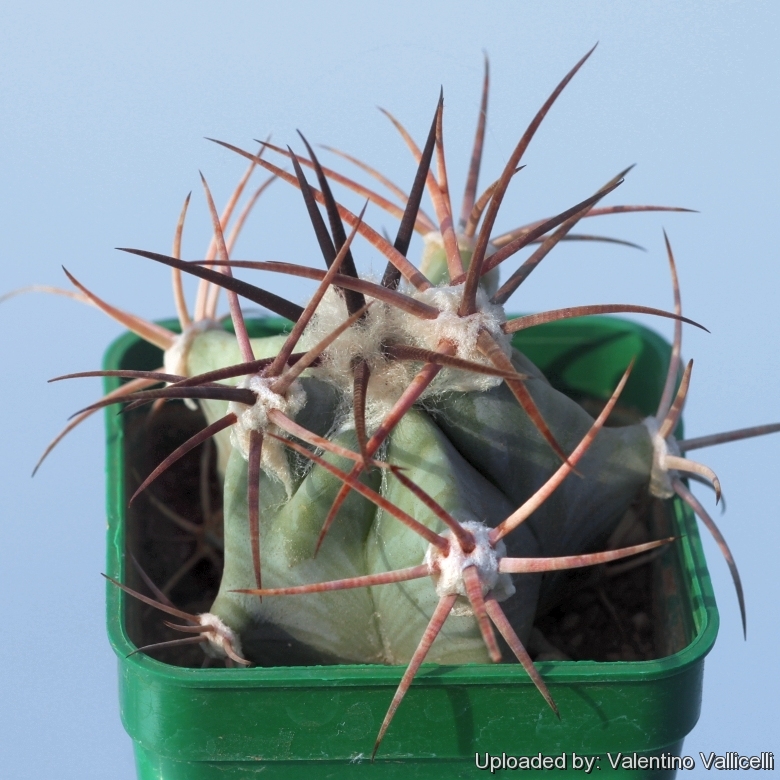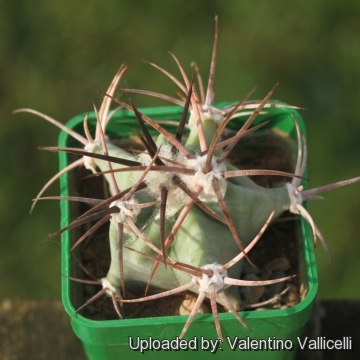
Echinocactus hybrid E. parryi x E. platyacanthus Photo by: Valentino Vallicelli
Origin and Habitat: Garden origin, but some of this hybrid has been reported in habitat too.
Synonyms:
Description: It is a barrel-shaped cactus obtained by crossing ? Echinocactus parryiSN|10367]]SN|938]] x ? Echinocactus platyacanthusSN|938]]SN|10367]]. The superb features of this rare plant are due to the intersection between the traits of the ancestors. It has inherited by Echinocactus parryiSN|10367]]SN|938]] the long colourful spination and by Echinocactus platyacanthusSN|938]]SN|10367]] the stout blue stem. This hybrid indeed is quite variable and differences among specimens may be considerable.
Stem: Subglobose or shortly cylindrical, flattened on top greyish-green to blue-green. The stem is supposed of intermediate dimension between the two parents, and may be rise to side shoots from old areoles.
Ribs: On young plants as few as 8, broad, high with pronounced tubercles and more or less undulate, but in old plants very numerous and rather thin. The juvenile Echinocactus looks quite different from the mature specimens. In fact, as with other Echinocactus and Ferocactus seedlings, the rib structure is not yet completely apparent, and they have making them look superficially like Mammillarias.
Areoles: Roundish, with abundant greyish wool remote on young plants, confluent in old flowering plants.
Spines: Dense, stout, subulate and ringed, chalky white to greyish-pink that turn a darker (redder) colouring when sprinkled with water. The spines in young specimens almost obscure the plant bodies.
Roots: Fibrous.
Flowers: Not seen.
Fruits: Not seen.
 Echinocactus hybrid E. parryi x E. platyacanthus Photo by: Valentino Vallicelli
Echinocactus hybrid E. parryi x E. platyacanthus Photo by: Valentino Vallicelli Echinocactus hybrid E. parryi x E. platyacanthus Photo by: Valentino Vallicelli
Echinocactus hybrid E. parryi x E. platyacanthus Photo by: Valentino VallicelliCultivation and Propagation: It share with Echinocactus platyacanthusSN|938]]SN|10367]] a certain ease of growth, and is not so difficult to grow on its own roots as Echinocactus parryiSN|10367]]SN|938]]. However it is slow-growing and very long-lived.
Soil: Provide the plant with extremely well-drained soils, as the plant are subject to crown and soft rot if it remains too moist.
Moisture: It is extremely xerophytic and adapted to very dry soils. It need a very good ventilation too.
Hardiness: It is supposed to be hardy to -9°C and can stay in a non heated green house. Cold hardiness increases with improved drainage, so keep plants as dry as possible in winter.
Sun exposure: It needs full sun, which will help to maintain the lustre of the spines.
Pests & diseases:Young plants are prone to mealy bug and red spider mite.
Propagation: Seed or grafting. The seeds germinate with difficulty and a low rate of success.













